Getting rid of scale in the iron: tips and prevention measures
The most common problem faced by the owners of irons - is scum and a dark patina on the sole, resulting from prolonged use and not too careful care. There are many reasons for the formation of scale: for example, instead of distilled water you poured the usual, and the result was a buildup inside the structure. This will certainly affect the performance of the iron, and the risk of tissue damage during ironing will increase. How to remove the unpleasant scum formed in the iron, we will describe in detail in our article.
Content
Causes of scaling
To work with the iron, in which the scum appeared, is very inconvenient. First, when the sole is slipping on the fabric, stainswhich in the future is very difficult to wipe off, which means that the thing can be completely destroyed. Secondly, it contributes to the rapid device failure: overheating can occur and the thermal fuse will simply “fly”.
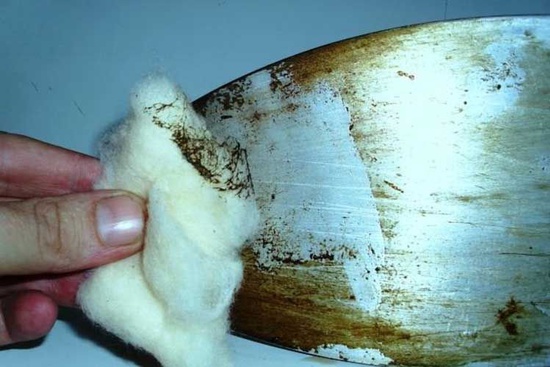
The reasons for the formation of scale in the iron a lot:
- Use unfiltered, hard water. In simple water from the tap high concentration of alkaline earth metal salts, which contribute to the formation of plaque on the internal parts of the iron.
- Incorrect temperature control during ironing. For example, you set the temperature to a maximum when ironing delicate fabrics (silk, organza, nylon). As a result, the red-hot sole eats through the fabric, and the soot remains on the first, which is not so easy to clean.
- The wrong combination of modes of ironing things from synthetics.
- The presence of chemicals on the products that you iron. For example, an incompletely washed detergent may react with the soleplate and leave a characteristic patina on it.
- Damage, scratches, cracks on the surface of the sole can cause a deposit.
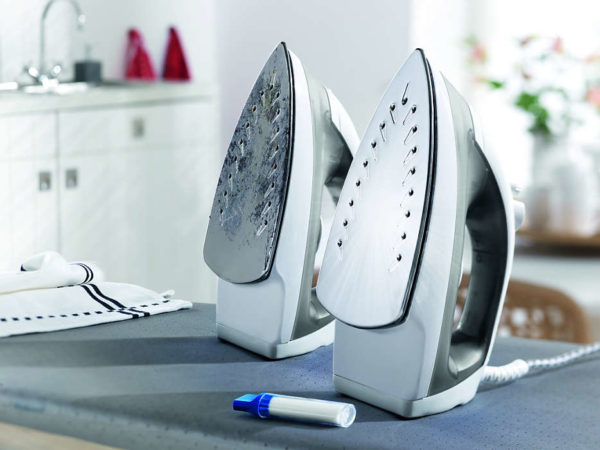
Descaling the iron with simple means
To clean the iron from scale and scale can be many ways. Use a specialized anti-scale agent.which can easily be found in household chemicals stores or refer to popular proven recipes. Of the variety of chemicals worth paying attention to antinucipine - simple and affordable for any buyer. This is a cheap, but effective solution in the fight against scum. With it, there is an effective removal of scale from washing machines, kettles, coffee machines.
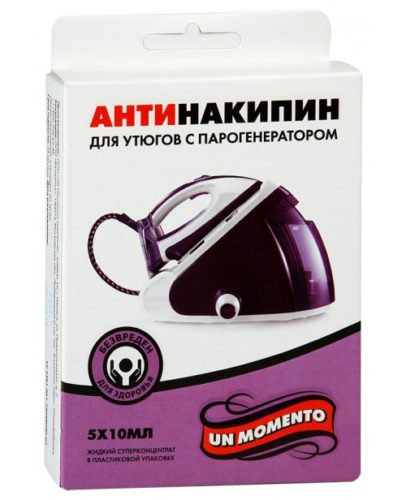
You can rid the iron of scale by spreading a couple of teaspoons of anti-scooping with water. This solution is poured into the instrument and left. for half an hour. Next, all the internal parts, it is desirable to rinse with cold clean water until complete removal of unsightly plaque.
Consider the popular ways of dealing with scale:
- Lemon acid. Two teaspoons of acid must be dissolved in hot, but not boiling water (about half a cup). In the resulting solution, moisten a soft cloth or gauze, and then firmly apply to particularly contaminated areas of the device. After 10-15 minutes, turn on the unit and wait until it heats up. When exposed to high temperatures, coupled with citric acid, scum will quickly begin to peel off the iron.
- Combination vinegar and citric acid - this is the answer to the question of how to remove scale in the iron. However, remember that citric acid perfectly dissolves plaque, and gauze moistened with a solution of table vinegar will help to finally polish the details to a shine. After cooling the device, it is desirable to wash it again with clean water.
- The use of tools to remove plaque and rust Cillit. To do this, warm the iron, turn the sole upwards and add a small amount of Cillit to the openings of the sole. After 15 minutes, remove all the dirt that has appeared on the iron and at the end, rinse the structure from the outside and inside with clean water.
- Mineral water. Mineral water is also an effective anti-scale agent. It is necessary to pour it into the tank and heat the device to the maximum temperature. Wait until steam begins to come out of the holes in the sole, then the scale will flake off with the water. Take precautions to avoid getting burned.
Iron can be washed household appliances. Now manufacturers produce a variety of specialized liquids or solids to destroy scale on the details of the structure. Before using them, carefully read the instructions for use.
Carbon cleaning
Nagar is a plaque formed directly on the bottom of the device. From the materials of the soles on the fly especially susceptible ceramic and aluminum. But regardless of the type of the soot, the soot is an unpleasant thing, it often spoils the fabric in the process of ironing, there are dark, burnt traces on the light materials that are very difficult to wash and clean. There are several ways to remove soot:
- In the shops you can find special pencil to remove carbon deposits. It is easy to use: it is enough to heat the appliance, gently rub its sole with a pencil and wipe the surface with a cloth. Under the influence of high temperatures, carbon deposits become softer and can be easily removed. Pencils are inexpensive, the only drawback of their use - an unpleasant smell in the cleaning process. However, it is worth it. To complete the procedure, wipe the sole of the cooled iron again with a damp cloth.
- Table 9% bite. It effectively removes dark scurf from both the outside and the inside. Dampen the vinegar well with a coarse cloth and gently wipe the sole without scratching or damaging it.If scale poorly exfoliates, it is recommended to add ammonia to vinegar to enhance the effect.
- Baking soda. Perhaps the most gentle cleaning method for irons. It is advisable to mix the baking soda with dishwashing detergent, and spread the resulting mass in a thin layer on the sole. Wait a short time and then carefully wipe the base with a soft cloth.
- Hydrogen peroxide - an effective solution in the fight against soot.
- Finely ground salt. Consider that salt with large crystals does not fit here, otherwise this method threatens to damage the sole. We also do not recommend cleaning the Teflon-coated irons with salt - it is easily deformed. Sprinkle with salt a small piece of fabric and run a hot iron surface over it several times. Nagara will quickly turn pale and peel off.
- Nail polish remover - also a good tool for removing soot. Moisten a cotton fleece with a solution and rub the spoiled surface. Only in any case, do not use this method if the sole of your iron with sapphire or teflon coating!
- Toothpaste - not the most effective, but in some cases effective way.
Iron self-cleaning
How to quickly remove scale from the steam iron, without using additional folk remedies and chemicals?
Models of modern irons are often equipped with a useful self-cleaning option. This means that the design of the device can be cleaned from the inside without assistance, automatically.
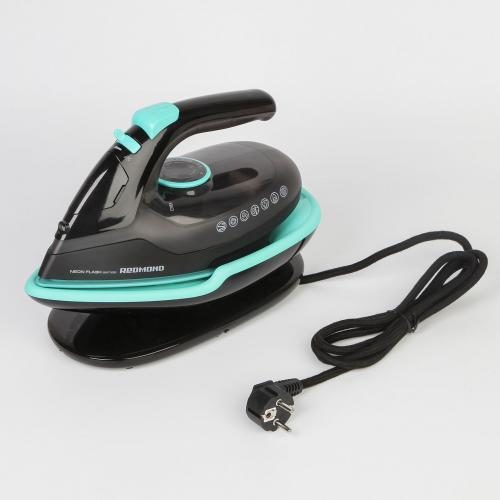
You can find out if there is such an opportunity in your iron and how this function works can be done by studying the instructions for use. In most cases, it is enough to collect the maximum volume of water in the tank and turn on the unit at the maximum heating temperature. The switched on device alternately turns on, turns off, cools down a little and heats up again. After the next disconnection, you need to disconnect the device from the power supply and press the self-cleaning button. It is easy to find on the front of the case.
Hold the appliance above the tank, where dirt and residues of scale will be drained along with the steam.
Steam will become a certain catalystaccelerating the detachment of scale and throwing it out. To remove any residue, shake the iron until it is completely clean. After completion of work, wipe the sole with the above means and carefully rinse the details of the iron with clean water.The final stage of purification, of course, should be carried out only with the cooled device to prevent burns.
Preventive measures
If you do not want to remove the frozen dark scum after each ironing, then the best precautions are best taken care of in advance.
- As often as possible, pour distilled water inside.
- If there is no possibility to buy water with distillate, then use high-quality filters for plumbing.
- Use a water softener, which is sold in specialized stores.
- Do not allow the appearance of cracks and damage on the sole of the iron, because it will be extremely difficult to remove carbon deposits from these places.
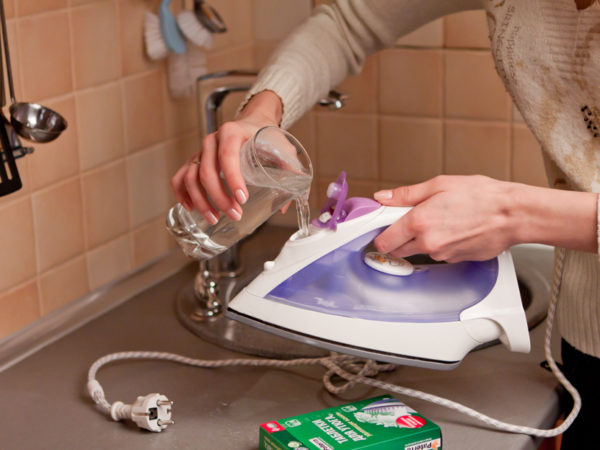
Conclusion
We brought several effective solutions and answered the question of how to get rid of scale in the iron. If you follow these recommendations, you can extend the life of this indispensable assistant in the house. As a result, the repair of electrical appliances is not needed, and your things will always look neat and neatly ironed.

/rating_off.png)












